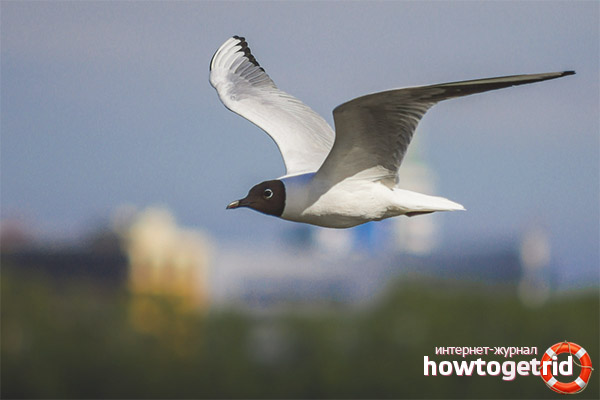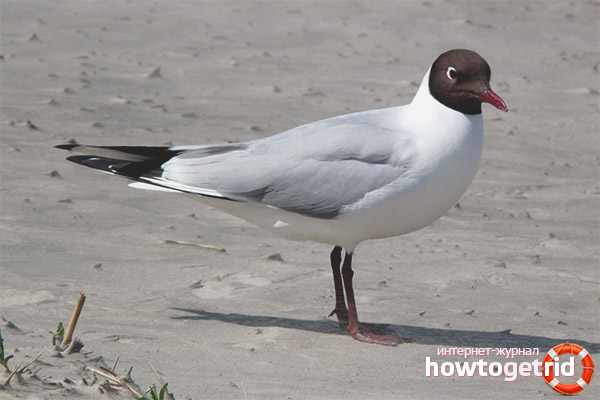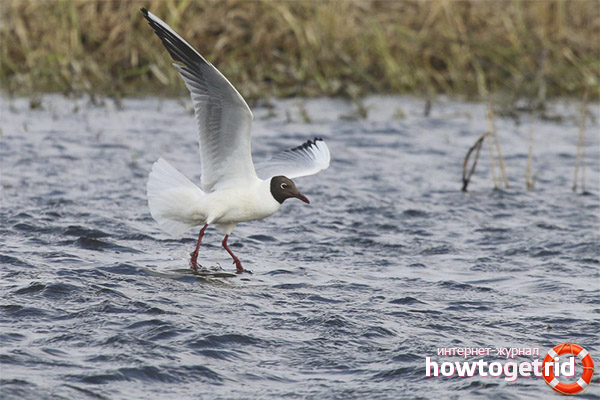The content of the article
At the word "seagull" the imagination draws a snow-white beautiful proud bird, soaring soaring over the sea surface. But in reality, gulls live in any more or less large body of water, not only by the sea, and there are more than 20 species. Today we will talk about a bird who has chosen reservoirs far from the sea for housing - even lake gulls settle in cities.
Description
The black-headed gull belongs to the gull family, the order is Charadriiformes. The appearance is the same as that of the birds of this family - of a dense physique, plumage is smooth, tail and wings are not too long, not very short. It is inferior in size to relatives of other species - the bird is small, a little larger than the city pigeon.
- Body length - from 38 to 44 cm.
- Mass - 200-350 g.
- Wingspan from 95 to 104 cm.
- The beak is red in color, somewhat curved, notches are located on the inside (so that the fish does not slip out).
The mandible is a bright red saturated color. - The plumage is mostly pink and white. The wings are mostly light gray.
- Paws of the same color as the beak are red.
In young birds, the color is gray-brown, on the wings there are many red and brown spots. Legs with beak are painted in yellow colors of dark tones. The tail is decorated with a strip of dark brown color.
Habitat
Distributed almost everywhere throughout Eurasia - from Iceland and the islands of Britain to the Far East, the Kuril Islands and Kamchatka. Lives even in the inhospitable cold north - lake gull nests are found in Greenland, the Scandinavian countries and some North American areas.
They also live in southern France, northern Italy, the post-Soviet space - in the Crimea, the Caucasus region, Turkestan. They live in the lakeside regions of Mongolia.
Food
It feeds mainly on insects, loves worms - it obtains them both in water and on land. It also catches crayfish, mollusks, a variety of small fish like bleak. Catches small birds, ruins their nests. Quite deftly it turns out to catch insects in the meadows - grasshoppers, dragonflies.
Often you can see flocks of birds hunting for food near fish processing plants - they collect unprocessed waste. Landfills are also visited, collecting discarded leftovers. When there is nothing to eat, plant seeds are sought - however, such food is consumed only at the time of nourishment. Do not disdain to eat carrion.
When fishing, the bird does not dive completely, only partially immerses its head in water.
Nesting
Puberty occurs in the second year of life. Moreover, females become sexually mature a little earlier than males. Birds remain faithful to one partner, that is, monogamous. It happens that in order to find a permanent life partner, one has to make several attempts, living with different partners.
Seagulls nest in colonies, the size of which varies from 5-6 pairs to several hundreds, or even thousands of birds. Often the colonies are heterogeneous in composition, it may contain gulls of other species or terns.
Nests settle on bumps in reservoirs with stagnant or slowly flowing water in places inaccessible to humans and animals.
Last year’s dried sedge, reeds, cattail and everything the gull is able to find is used as building material. Any rubbish lying around is suitable for construction - scraps of nets, canned tins, feathers, and so on.
The nesting device is very simple - a low, cone-shaped flooring with a round bottom is made from plants and improvised materials, in the middle of which a recess for eggs is constructed. If the place is dry, then the flooring is thin, but the more damp in the construction site, the denser and thicker the bottom. Both representatives of the pair participate in the construction.
The masonry consists of 3 eggs of gray or bluish color, mottled with brown spots. The female incubates eggs for two to three and a half weeks. Around mid-May, chicks appear, and already covered with feathers of ocher-brown or black-brown color are born. This color plays a camouflage role and allows you to be invisible to enemies. Children are in the nest for 10-12 days, fed by parents. Both birds are involved in this process. Feeding occurs in a standard way - either feed the chicks from the beak to the beak, or put food on the bottom of the nest, and the kids pick and eat it. After about a month, young birds begin to try to fly.
Wintering

Overwintering most gulls go to the Mediterranean coast, the north of the African continent or the countries of Eastern Europe. In the territory of the post-Soviet space, warm southern regions are chosen for the winter period - the Caspian or Black Sea coast, Issyk-Kul and Balkhash lakes.
Interesting Facts
- As soon as the young individual learns to fly, it immediately leaves the parental nest.
- The black-headed gull belongs to those few species that live not only in areas near the sea, but also inland.
- The appetite of the bird is good; it is a rather voracious bird. About 200-230 grams of insects are consumed per day. And this, not counting the fish.
- In nesting places there is an unceasing constant din and noise. Quite often it comes to skirmishes and fights. Moreover, any trifle can serve as an excuse: for example, two birds quarreled over a piece of fish and, right away, a good part of the colony can get into it.
- The gull has a peculiar voice - it is difficult to characterize. Here is laughter, and the cry of an angry cat, and the resemblance to the cry of a raven. Gulls cry all the time, never shutting up.
- If during a period of hatching or feeding children somewhere nearby danger or an uninvited guest is noticed, the whole colony begins to worry - the birds take off, vote vigorously, trying to pour as much as possible the droppings on the offender.
- Seagulls tend to eat not only the eggs of other birds, but also colony neighbors. Sometimes they even eat chicks. Therefore, birds sometimes have to lay several times.
Video: lake gull (Chroicocephalus ridibundus)











Submit